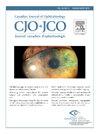Impact of eyewear insurance coverage on utilization of eyecare providers in Ontario, Canada
IF 2.8
4区 医学
Q1 OPHTHALMOLOGY
Canadian journal of ophthalmology. Journal canadien d'ophtalmologie
Pub Date : 2024-08-22
DOI:10.1016/j.jcjo.2024.08.005
引用次数: 0
Abstract
Objective
To obtain prescription eyewear in Ontario, eye exams must be performed by optometrists or ophthalmologists (eye care providers [ECPs]). In 2004, government-insured routine eye exams were delisted for Ontarians aged 20–64 leaving eye exam coverage only for those aged ≤19 and 65+. We assessed whether having eyewear insurance impacts Ontarians’ utilization of ECPs.
Design
Cross-sectional survey.
Participants
Ontarians aged 12+ without diabetes responding to the Canadian Community Health Survey in 2003, 2005, and 2013/2014.
Methods
We compared the utilization of ECPs by eyewear insurance status and eligibility for government-funded eye exams. Individuals with eyewear insurance funded by employers, government or privately were considered to have insurance.
Results
ECP utilization was significantly higher in Ontarians with eyewear insurance versus those without, in all survey years and all age groups, including those eligible for government-funded eye exams (e.g., 66.4% vs 59.1% [p < 0.05] for the 65+). This higher level of utilization was particularly evident among Ontarians aged 20–64 in 2013/2014, when this group no longer had government-funded eye exams (34.9% vs 19.9% among 20–39-year-olds, 43.4% vs 32.9% among 40–64-year-olds, p < 0.05 for both). Adjusting for confounding effects, the likelihood of visiting an ECP was greater among Ontarians with eyewear insurance than those without (adjusted prevalence ratio 1.26 for Ontarians aged 12+ and 1.41 for those aged 20–64; p < 0.05 for both).
Conclusions
Lack of eyewear insurance negatively impacts the utilization of ECPs, even among Ontarians eligible for government-funded eye exams, where the cost barrier for eye exams has been removed by the Ontario government.
Objectif
Pour obtenir des lunettes d’ordonnance en Ontario, les examens de la vue doivent être réalisés par des optométristes ou des ophtalmologistes (prestataires de soins oculaires [PSO]). En 2004, le gouvernement a retiré les examens de la vue de routine de l’Assurance-santé des Ontariens de 20 à 64 ans, seuls les bénéficiaires de ≤ 19 ans et de 65 ans et plus demeurant assurés. Nous avons vérifié si la couverture d’assurance pour les lunettes d’ordonnance a influé sur le degré de consultation des PSO par les Ontariens.
Nature
Étude transversale.
Participants
Ontariens non diabétiques âgés de 12 ans et plus qui ont pris part à l’Enquête sur la santé dans les collectivités canadiennes en 2003, en 2005 et en 2013/2014.
Méthodes
Nous avons examiné le degré de consultation des PSO en fonction de l’assurance lunettes et de l’admissibilité du patient à bénéficier d’examens oculaires remboursés par le gouvernement. On a considéré comme assurés tous les sujets dont l’assurance lunettes était payée par un employeur, le gouvernement ou une instance privée.
Résultats
Le degré de consultation des PSO était significativement plus élevé chez les Ontariens qui disposaient d’une assurance lunettes, comparativement aux sujets sans assurance, et ce, lors de chacune des années de l’enquête et dans tous les groupes d’âge, y compris les sujets admissibles aux examens de la vue assurés par le gouvernement (p. ex., 66,4 % vs 59,1 % [p < 0,05] chez les sujets de 65 ans et plus). Le degré plus élevé de consultation était particulièrement évident chez les Ontariens âgés de 20 à 64 ans en 2013/2014, lorsque les examens de la vue assurés par le gouvernement avaient pris fin (34,9 % vs 19,9 % chez les sujets de 20 à 39 ans; 43,4 % vs 32,9 % chez les sujets de 40 à 64 ans; p < 0,05 dans les 2 cas). Une fois pris en compte les facteurs de confusion, la probabilité de consulter un PSO était plus élevée chez les Ontariens qui disposaient d’une assurance lunettes que chez les sujets sans assurance (rapport de prévalence ajusté : 1,26 pour les Ontariens âgés de 12 ans et plus et 1,41 pour les Ontariens âgés de 20 à 64 ans; p < 0,05 dans les 2 cas).
Conclusions
L’absence d’assurance lunettes a des répercussions négatives sur le degré de consultation des PSO, même de la part des Ontariens admissibles aux examens de la vue assurés par le gouvernement, pour lesquels le gouvernement de l’Ontario a éliminé l’obstacle du coût de tels examens.
加拿大安大略省眼镜保险对眼镜医疗机构使用率的影响。
目的:在安大略省,要获得处方眼镜,必须由验光师或眼科医生(眼科保健提供者 [ECP])进行眼科检查。2004 年,政府不再为 20-64 岁的安大略省人提供常规眼科检查,只为年龄在 19 岁以下和 65 岁以上的人提供眼科检查。我们评估了拥有眼镜保险是否会影响安大略省人对 ECP 的使用:设计:横断面调查:方法:比较 ECPs 的使用情况:我们根据眼镜保险状况和政府资助的眼科检查资格对 ECP 的使用情况进行了比较。由雇主、政府或私人出资购买眼镜保险的个人被视为有保险:在所有调查年份和所有年龄组中,有眼镜保险的安大略省人与没有眼镜保险的安大略省人相比,ECP 的使用率明显更高,包括那些有资格接受政府资助的眼科检查的人(例如,65 岁以上人群的使用率为 66.4% 与 59.1% [p < 0.05])。在2013/2014年度,20-64岁的安大略省人中,这种较高的利用率尤为明显,因为这一年龄组的人不再享受政府资助的眼科检查(20-39岁的人中,34.9%对19.9%;40-64岁的人中,43.4%对32.9%,两者的P均<0.05)。在对混杂效应进行调整后,有眼镜保险的安大略省人去ECP就诊的可能性要大于没有眼镜保险的安大略省人(12岁以上安大略省人的调整患病率比为1.26,20-64岁安大略省人的调整患病率比为1.41;两者的P均<0.05):缺乏眼镜保险对 ECP 的使用产生了负面影响,即使是有资格接受政府资助的眼科检查的安大略省人也是如此,因为安大略省政府已经消除了眼科检查的费用障碍。
本文章由计算机程序翻译,如有差异,请以英文原文为准。
求助全文
约1分钟内获得全文
求助全文
来源期刊
CiteScore
3.20
自引率
4.80%
发文量
223
审稿时长
38 days
期刊介绍:
Official journal of the Canadian Ophthalmological Society.
The Canadian Journal of Ophthalmology (CJO) is the official journal of the Canadian Ophthalmological Society and is committed to timely publication of original, peer-reviewed ophthalmology and vision science articles.

 求助内容:
求助内容: 应助结果提醒方式:
应助结果提醒方式:


